Inside and Outside
Houseplant Envy
I wonder why my houseplants look so unattractive, at least compared to some other people’s houseplants. I was recently awed by the lushness and beauty of a friend’s orchid cactii, begonias, and ferns. I also grow orchid cactii and ferns, so what’s with mine?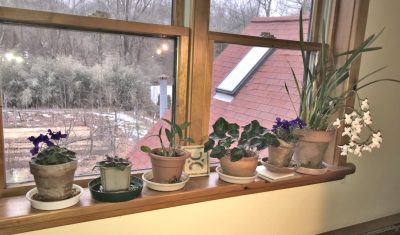
Perhaps the difference is that other’s houseplants have a cozy, overgrown look. Mine don’t. Most of my houseplants get repotted and pruned, as needed, for best growth. Every year, every two years at most, they get tipped out of their pots, their roots hacked back, then put back into their pots with new potting soil packed around their roots. In anticipation of lush growth, stems also get pruned to keep the plants from growing topheavy.
Rather than being scattered willy-nilly throughout the house or clustered cozily in corners, as in friends’ homes, my houseplants get carefully sited. For best growth, plants, especially flowering and fruiting plants, need abundant light, something that’s at a premium this time of year. So my houseplants huddle near south-facing windows like baby chicks near a heat lamp. And then in summer, when light, even indoors, becomes more adequate and the plants could move a bit back from the windows, I move them all outside so that summer sunlight, rain, and breezes can really get them growing.
What can I say? I’m too focussed on good growth, and that’s not necessarily what makes for the prettiest houseplant. It’s the difference between a lush plant packed into and overflowing its pot, along with elbow to elbow neighbors, versus one that’s had its soil refreshed frequently, its stems thinned out and pruned back, always with younger stems raring to grow. I can’t help myself.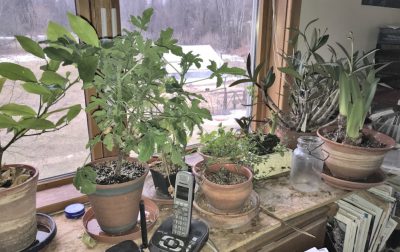
Choice of houseplants also comes into play. Houseplants that are prettiest for the longest period of time — and need less light — are those valued for the shapes and colors of their leaves. I gravitate to houseplants with fragrant flowers or fruits, or — even better — fragrant flowers and fruits. Pumping out lots of flowers and, especially, fruits demands much more energy from a plant than just growing leaves. And that energy comes from sunlight and young leaves that are efficient at working with that light. Hence the repotting and clustering near sunny windows of my houseplants.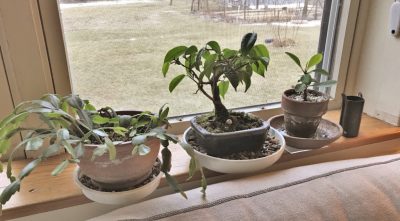
Perhaps it’s also a matter of the “grass is greener,” to me, in someone else’s house. I’ll start looking at my houseplants more with the eye of an appreciative visitor.
Winter Cold: The Good and the Bad
The temperature was 9° and we were on our way to go cross-country skiing when a friend asked if there was any benefit to the cold weather. Plantwise, that is. We knew the weather was good for skiing. Interesting question, and the answer is “yes.”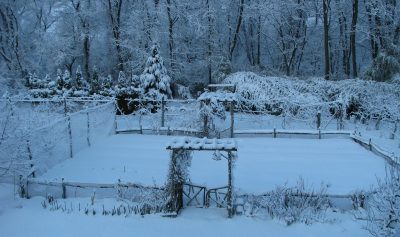
The first benefit that comes to mind is the effect of cold on diseases, certain diseases, at least. The cold kills them. Peach leaf curl, for instance, is a disease that overwinters in peach buds, resulting in leaves that unfold thickened and twisted and eventually yellow and fall so fruiting and growth suffer. Except in cold winters. My winters are usually cold enough so this disease is rarely a problem.
A number of summers ago late blight disease of tomato went on the rampage here and throughout the Northeast. That disease can’t spend the winter this far north because it’s too cold. In that past summer and some other summers, the disease hitchhikes north on infected plants brought here or, when winds and humidity are just right, hopscotches along north from one infected field to the next.
Insect pests that overwinter in the soil are more damaged the colder the soil gets, and bare soil gets colder than mulched soil, all of which highlights the balancing acts necessary in gardening.
Pests notwithstanding, bare ground isn’t good for plants and soil. Plant roots are more likely to be damaged by the increased exposure and, especially evergreens, are more apt to dry out because more water will evaporate from bare ground and because roots have a hard time drinking in water from frozen ground. Bare ground is also subject to erosion and nitrogen loss.
On the other side of the coin, bare soil goes through more cycles of freezing and thawing, which breaks up and moves around soil particles, in effect tilling the soil. Back to the previous side of the coin, that freezing and thawing can move soil around enough to heave plants, especially small or newly rooted plants, up and out of the ground.
So, I like cold weather for my plants. But I mulch heavily. And I especially like it, as do the plants — and, admittedly, some pests — when there’s an additional blanket of snow over the ground. It also makes for good skiing.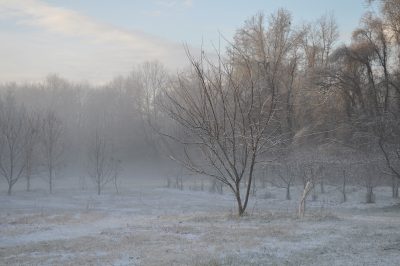


I dug-out today from a storm system that started on Sunday. Hate shoveling snow but it sure does look pretty out in the garden!
I live about 30 miles north of Seattle and we are on pace to have our coldest February on record. I was glad to see this post to give me an optimistic view on the cold. I am zone 8b so my cold may not seem like much to other areas but I don’t usually get below about 15-20 most years but we’ve been hitting that and lower.
I have 5 acres that are slowly being converted into an edible food forest (370 edible perennial plants to date) as well as a dinosaur garden that features many tropical looking plants in a temperate climate. With my zone being warm-ish, I am growing many sub-tropicals that need micro climates. I have used house eves, large rocks, south slopes, frost blankets, Christmas lights and so on to keep the cold air away from my more tender plants.
The one saving grace is we received about 15 inches of snow to go along with the cold and the snow came before the coldest nights. I’m hoping this layer of insulation will have offered extra protection from the cold starry nights after the snow falls.
A benefit from the snow, (indirect from the cold) that I heard recently on Mike McGrath’s show, You Bet Your Garden, he mentioned that snow also acts as a fertilizer containing nitrogen and other trace minerals. I haven’t looked into the science of why but I had not heard that before.
I had heard that lightning storms “rain down” nitrogen due to the bolts breaking atmospheric nitrogen bonds. I had not heard this about snow before though.
I always enjoy your books, posts, and guest appearances on shows like Mike’s and Margaret Roach and many others. It has inspired me to see what the possibilities of different edibles can be grown in my area.
Keep up the good work!
As far as the nitrogen from lightening and snow, yes, it’s true, although it’s a very small amount, perhaps about 10 pounds or less per acre.
Can you recommend some fragrant houseplants? I have jasmine and a fitful gardenia … always looking for more options. I’d be interested with any you recommend or have had success with.
Definitely citrus, and you get fruit also!